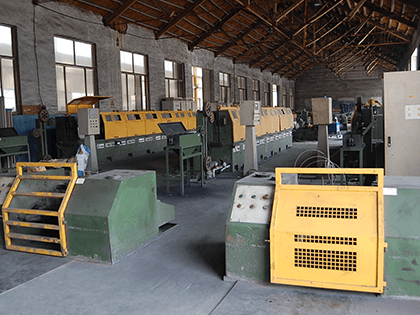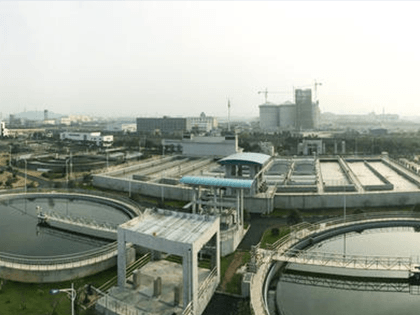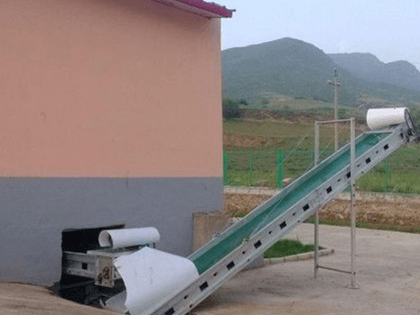Technical development of paper making reclamation technology
Author: Taida machine Release time:2016-08-19
Reading guidance:Sludge is the end product of paper making waste water treatment process, each producing a ton of recycled paper, containing approximately 65% of the content of sludge 700kg, the output is equal in size
Sludge is the end product of paper making waste water treatment process, each producing a ton of recycled paper, containing approximately 65% of the content of sludge 700kg, the output is equal in size to the municipal sewage plant of 5 to 10 times, and the complex composition, high water content, processing difficulty is big. Therefore, disposal of sludge asked questions has become bound to the development of paper making plant. Many studies have shown that, rich content of paper making sludge biomass, organic matter content of 40% to 50%, containing mainly cellulose, hemicellulose and lignin and other organic polymer and filler, condensed agent and does not contain heavy metals, is a kind of biomass resources.
1. new development of composting technology
Paper sludge treatment, the enterprise should formulate different approach according to its geographical environment and the status of land resource. In the United States sludge land use accounted for 33% of the total output of sludge, Portugal is as high as 80%, 25 percent of Germany and Japan 11% and 51%. In Britain the British general Wanli factory quoted the mechanical composting technique of Dano company, with an annual output of 4 million tons of powdered fertilizer. Earthworms are expensive, per kilogram can be sold more than 20 to 30 yuan, some of Poland's chemical plant using the earthworm treatment sludge, has a no smell, like humus containing high nutritional value and is suitable to be used as plant growth Naga Yoji earthworm fertilizer. Zhou Shaoqi ao- shortened in order to shorten the time. The derivation of the composting technology in recent years has also made new development of paper mill sludge compost research results show that in high temperature aerobic composting process to achieve high temperature phase (80 DEG C) from the original 3D 1D, high-temperature aerobic fermentation period from 20d 10d, moisture from 55% dropped to 40% below, and separation to a thermophilic actinomycetes strains. The morphology and physiological and biochemical characteristics and high-temperature actinomycetes belong to the typical kind of similar to the strain tolerance to 80 DEG C high temperature, can maintain a long period of high temperature time and shorten the composting fermentation period were studied before and after composting and planting crops and soil heavy metal forms. It is shown in result that companies use effective biological N Fe-M before and after the addition of sludge compost in soil Cu, Ni, Cr, P, B mainly in residual form, Zn mainly in oxidation state exists in the form of the two forms of heavy metals are very small, and C D mainly in exchangeable and carbonate bound, biological effectiveness greatly. Adding compost soil heavy metal biological effectiveness decreased when adding compost soil on crops, soil heavy metals in biological effectiveness will be further reduced. Shandong Asia Pacific SSYMB earthworm treatment sludge, after digestion of earthworm manure fertilizer and agricultural fertilizer, can be widely used for crops, horticulture, lawns and municipal greening.
2. Energy saving power generation technology
Paper mill sludge containing high calorific value (10m use J / k g), burning can not only reduction, but also can eliminate the odor, kill pathogenic bacteria, parasite eggs and heat recovery. 55% of the sewage sludge from Japan, 11% of the 25% of the sludge in the United States and Europe sludge has been used for incineration power generation. American company sludge, waste wood, coal and other fuel mixed combustion technology, devoted to the study of the different multiple material CBF boiler; a paper company in Japan made by burning the sludge and bark and heavy oil combustion of CFB boiler (42), the remaining heat generation. Hamburg Cobb Lenhoff sewage treatment plant sludge using concentrated first, and then to digest, dehydration, drying, finally incineration treatment technology, sludge circulation treatment mode. The mode in the sludge incineration power generation at the same time, the sludge incineration heat drying of sludge, the realization of the external fuel demand for zero expected effect, and provides the sewage factory needs electricity and heat of 60% and 100%, greatly improves the economy of sludge disposal, reduce the operation cost. In 2003, and Nippon paperboard company with paper making sewage sludge as fuel, the generated heat to generate electricity (capacity of 1.4 million KW h), and can eliminate the dioxin without the need for any oil fuel.
Mixing the sludge incineration power generation technology started late, but has made breakthrough progress. Someone using a fluid bed incineration of sludge and coal, calcium sulfur ratio 3: 1, SO2 and NOx emissions have reached the national standard, and recycling the heat. There are scholars study shows that sludge in bed combustion share in 48% to 65%, incineration flue gas SO2, no and N2O gas phase pollutants emission concentration is low, and meet emissions requirements. Can also use of biomass gasification technology treatment of paper making waste sludge to produce fuel gas in addition to dry raw materials required, and about half can be used to produce the actual economic benefits, and deinking sludge thermal recycling
Its value is better than biochemical sludge and waste water sludge
3. Applied to building materials
Some scholars use the production of new wall materials residue and sludge of papermaking, technical and economic index is better than the clay brick in.2008, Jiangsu Lianyungang Hengchang environmental resources development company has successfully developed using waste paper pulp sludge as filler to prepare PP-n plastic guardrail, experts believe this result accords with the state environmental protection and utilization of resources of the same industry policy. Using paper mill sludge production of building energy-saving light brick, micro pores can be used in high temperature burning after leaving the organic fiber, improve the insulation performance of sintered brick, reduce the use of building energy consumption, and can be generated by the combustion of organic fiber heat to reduce production energy consumption, energy saving and environmental protection with social and economic benefits. In addition by comparison the chemical composition of sewage sludge and clay, and clay products that form the sludge after the burning of the basic approach. In recent years the development of the Deinking sludge of high quality construction plate method, do not need to use adhesive and cement or any harmful additives, the workshop is not solid waste, all the bits and pieces, sanding residual materials are in the production of recycling.
4. Applied for making industrial raw materials
The latest research shows that sludge production of carbonized sludge (activated carbon), ceramic, artificial zeolite with low cost and good environmental and economic benefits of the notable features. In 2008, Japan to sludge dewatering of filter cake as raw materials, research and development of the high performance activated carbon, with small density, light weight, porous, ratio surface area, decolorization and deodorization of, the pores of the specific surface area is city of the product sales 118 times more, adsorption ability greatly enhanced. On COD and some heavy metal ions have a high removal rate, is a kind of excellent organic waste water treatment adsorption flocculant. Study on technology of American Illinois the paper mill sludge drying, smashing after mixing it with zinc oxide, under a certain temperature chemical activation, the successful development of a paper mill sludge production of activated carbon and catalyst carbon support materials, and traditional activated carbon production process compared to the lower cost. According to another report containing 50% filler of sludge after calcination, calcium carbonate, kaolin will generate a very uniform mineral calcium aluminum silicate, the mineral can used to produce high filler and re used in the paper making, is an important manifestation of circular economy.
5. Recycle paper making sludge as raw materials
ECC international company in the United Kingdom by controlling calcination temperature recovery method, in different decomposition temperature of combustion, use of deinking sludge in calcium carbonate and kaolin in the production of paper filler and coating pigment, the pigment whiteness between 70% to 85%ISO. British Aylesford newsprint factory using North American technology from the waste paper deinking sludge recycling fiber and filler, filler is mainly containing calcium carbonate and clay, used in the paper making can improve paper smoothness, gloss and transparency. In addition, there are scholars from paper mill sludge with acid precipitation method to extract lignin, extracted product were sulfonated, modified products Determination by the surface activity has improved significantly.
1. new development of composting technology
Paper sludge treatment, the enterprise should formulate different approach according to its geographical environment and the status of land resource. In the United States sludge land use accounted for 33% of the total output of sludge, Portugal is as high as 80%, 25 percent of Germany and Japan 11% and 51%. In Britain the British general Wanli factory quoted the mechanical composting technique of Dano company, with an annual output of 4 million tons of powdered fertilizer. Earthworms are expensive, per kilogram can be sold more than 20 to 30 yuan, some of Poland's chemical plant using the earthworm treatment sludge, has a no smell, like humus containing high nutritional value and is suitable to be used as plant growth Naga Yoji earthworm fertilizer. Zhou Shaoqi ao- shortened in order to shorten the time. The derivation of the composting technology in recent years has also made new development of paper mill sludge compost research results show that in high temperature aerobic composting process to achieve high temperature phase (80 DEG C) from the original 3D 1D, high-temperature aerobic fermentation period from 20d 10d, moisture from 55% dropped to 40% below, and separation to a thermophilic actinomycetes strains. The morphology and physiological and biochemical characteristics and high-temperature actinomycetes belong to the typical kind of similar to the strain tolerance to 80 DEG C high temperature, can maintain a long period of high temperature time and shorten the composting fermentation period were studied before and after composting and planting crops and soil heavy metal forms. It is shown in result that companies use effective biological N Fe-M before and after the addition of sludge compost in soil Cu, Ni, Cr, P, B mainly in residual form, Zn mainly in oxidation state exists in the form of the two forms of heavy metals are very small, and C D mainly in exchangeable and carbonate bound, biological effectiveness greatly. Adding compost soil heavy metal biological effectiveness decreased when adding compost soil on crops, soil heavy metals in biological effectiveness will be further reduced. Shandong Asia Pacific SSYMB earthworm treatment sludge, after digestion of earthworm manure fertilizer and agricultural fertilizer, can be widely used for crops, horticulture, lawns and municipal greening.
2. Energy saving power generation technology
Paper mill sludge containing high calorific value (10m use J / k g), burning can not only reduction, but also can eliminate the odor, kill pathogenic bacteria, parasite eggs and heat recovery. 55% of the sewage sludge from Japan, 11% of the 25% of the sludge in the United States and Europe sludge has been used for incineration power generation. American company sludge, waste wood, coal and other fuel mixed combustion technology, devoted to the study of the different multiple material CBF boiler; a paper company in Japan made by burning the sludge and bark and heavy oil combustion of CFB boiler (42), the remaining heat generation. Hamburg Cobb Lenhoff sewage treatment plant sludge using concentrated first, and then to digest, dehydration, drying, finally incineration treatment technology, sludge circulation treatment mode. The mode in the sludge incineration power generation at the same time, the sludge incineration heat drying of sludge, the realization of the external fuel demand for zero expected effect, and provides the sewage factory needs electricity and heat of 60% and 100%, greatly improves the economy of sludge disposal, reduce the operation cost. In 2003, and Nippon paperboard company with paper making sewage sludge as fuel, the generated heat to generate electricity (capacity of 1.4 million KW h), and can eliminate the dioxin without the need for any oil fuel.
Mixing the sludge incineration power generation technology started late, but has made breakthrough progress. Someone using a fluid bed incineration of sludge and coal, calcium sulfur ratio 3: 1, SO2 and NOx emissions have reached the national standard, and recycling the heat. There are scholars study shows that sludge in bed combustion share in 48% to 65%, incineration flue gas SO2, no and N2O gas phase pollutants emission concentration is low, and meet emissions requirements. Can also use of biomass gasification technology treatment of paper making waste sludge to produce fuel gas in addition to dry raw materials required, and about half can be used to produce the actual economic benefits, and deinking sludge thermal recycling
Its value is better than biochemical sludge and waste water sludge
3. Applied to building materials
Some scholars use the production of new wall materials residue and sludge of papermaking, technical and economic index is better than the clay brick in.2008, Jiangsu Lianyungang Hengchang environmental resources development company has successfully developed using waste paper pulp sludge as filler to prepare PP-n plastic guardrail, experts believe this result accords with the state environmental protection and utilization of resources of the same industry policy. Using paper mill sludge production of building energy-saving light brick, micro pores can be used in high temperature burning after leaving the organic fiber, improve the insulation performance of sintered brick, reduce the use of building energy consumption, and can be generated by the combustion of organic fiber heat to reduce production energy consumption, energy saving and environmental protection with social and economic benefits. In addition by comparison the chemical composition of sewage sludge and clay, and clay products that form the sludge after the burning of the basic approach. In recent years the development of the Deinking sludge of high quality construction plate method, do not need to use adhesive and cement or any harmful additives, the workshop is not solid waste, all the bits and pieces, sanding residual materials are in the production of recycling.
4. Applied for making industrial raw materials
The latest research shows that sludge production of carbonized sludge (activated carbon), ceramic, artificial zeolite with low cost and good environmental and economic benefits of the notable features. In 2008, Japan to sludge dewatering of filter cake as raw materials, research and development of the high performance activated carbon, with small density, light weight, porous, ratio surface area, decolorization and deodorization of, the pores of the specific surface area is city of the product sales 118 times more, adsorption ability greatly enhanced. On COD and some heavy metal ions have a high removal rate, is a kind of excellent organic waste water treatment adsorption flocculant. Study on technology of American Illinois the paper mill sludge drying, smashing after mixing it with zinc oxide, under a certain temperature chemical activation, the successful development of a paper mill sludge production of activated carbon and catalyst carbon support materials, and traditional activated carbon production process compared to the lower cost. According to another report containing 50% filler of sludge after calcination, calcium carbonate, kaolin will generate a very uniform mineral calcium aluminum silicate, the mineral can used to produce high filler and re used in the paper making, is an important manifestation of circular economy.
5. Recycle paper making sludge as raw materials
ECC international company in the United Kingdom by controlling calcination temperature recovery method, in different decomposition temperature of combustion, use of deinking sludge in calcium carbonate and kaolin in the production of paper filler and coating pigment, the pigment whiteness between 70% to 85%ISO. British Aylesford newsprint factory using North American technology from the waste paper deinking sludge recycling fiber and filler, filler is mainly containing calcium carbonate and clay, used in the paper making can improve paper smoothness, gloss and transparency. In addition, there are scholars from paper mill sludge with acid precipitation method to extract lignin, extracted product were sulfonated, modified products Determination by the surface activity has improved significantly.
:International disposal experience and control strategy for sludge :Leaching of heavy metals in sludge disposal
Relevant news
- 2016-01-12OSC-II Model Sludge Dryer Deliv
- 2016-01-1215T/Day Aerobic Dynamic Ferment
- 2016-01-12Matters Should Be Paid Attentio
- 2016-01-12Methods exploration of chemical
- 2016-01-12Analysis of circulating fluid b
Industry trends
- 2016-01-12Comparison Between Different Sl
- 2016-01-12Adding Calcium and Stable Dispo
- 2016-01-12Sludge Treatment: Methods for S
- 2016-01-12Use Dyeing Sludge As Resource
- 2016-01-12Current situation of sludge dis
Hot spots
Hot-sale products

- Leather Industry Sludge Drying
Production Capacity:1-2200t/h

- Welding Plating Sludge Drying S
Production Capacity:1-2200t/h

- Municipal Sludge Drying Solutio
Production Capacity:1-2200t/h

- Manure Sludge Drying Solution
Production Capacity:1-2200t/h
 中文
中文 English
English Home
Home
